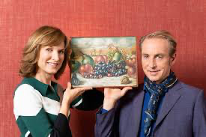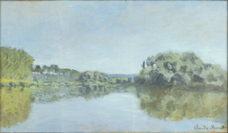Almost forty years ago, working for Ira Spanierman Gallery, I was participating in the San Francisco Art and Antiques Show. Regional antiques shows were a major opportunity to acquire works for our New York-based gallery. In those days before cell phones, we took out ads in the local newspaper and enlisted a local answering service to take the calls. The ads invariably got a lot of response from people who were certain that they owned masterpieces – think of it as a very low-tech forerunner to Antiques Roadshow. I viewed many works, usually in the trunks of cars in the parking lot, since the owners were not allowed to bring items onto the show floor.
Occasionally, however, it was not possible for the owner to bring the work to me. Once, responding to a message, I found myself speaking with an elderly gentleman who told me, “I’m 82 and want to settle my estate before I die. I have four large paintings by Frederic Remington.” He couldn’t get them into his car, so I made an appointment to drive down to his Palo Alto home the following morning.
Arriving in Palo Alto the next day, I was greeted by the owner, who invited me inside and then asked me to have a seat while he went through the research he had conducted on the paintings. My heart sank. It is always a bad sign when a painting’s owner insists that you listen to a lot of “research” authenticating a painting before he will allow you to actually view the piece. Sure enough, when I was finally shown the paintings, it was obvious to me that they were not by Remington.
“Did Harold McCracken ever see these works?” I inquired. There was no formal catalogue raisonné for Remington in those days, but Harold McCracken, the late founder of the Buffalo Bill Historical Center in Cody, Wyoming, had published several books on the artist and was widely regarded as the expert in authenticating Remington’s paintings.
“HAROLD MCCRACKEN!” the man replied, practically spitting in disgust. (It is also a bad sign when a painting’s owner spits in disgust when the expert’s name is mentioned.) “Why, I took these paintings up to Cody years ago to show them to him! He looked at them, and then he showed me around the museum without saying another word!” I soon made my escape, saying that I had to speak with Mr. Spanierman about the works and would be in touch.

There’s a BBC television show called Fake or Fortune that Roberta and I have been watching recently. It was recommended to us by our daughter as a pleasant escape from today’s seemingly unending parade of grim news. In Fake or Fortune, art dealer Philip Mould and journalist Fiona Bruce examine a recently found work attributed to a famous artist and attempt through scientific research, historical sleuthing, and travel to picturesque sites to determine if the work is real.
In the first episode, the hosts took up the case of a painting, Banks of the Seine at Argenteuil, signed Claude Monet. The work had been withdrawn from a major British auction when Daniel Wildenstein, compiler of the catalogue raisonné, had refused to accept it as genuine. The work had subsequently been purchased for a fraction of the auction estimate by its current owner, who was determined to prove Wildenstein wrong.

Mould and Bruce had the painting’s provenance researched, had it examined under X-rays, ultraviolet and infrared light, looked up the records of the maker of the painting’s frame, and had the paint chemically analyzed. Some of their research seemed solid to me, but I was put off by the breathless manner in which they announced their latest findings, accompanied by dramatic music straight out of Game of Thrones. There was also far too much speculation – “Well, Monet lived in Argenteuil in 1885, when we think this painting was done, so that’s a solid link.” I know the producers felt they had to try to inject drama into the proceedings to try and keep the general public’s interest, but I found the constant attempts to gin up excitement irritating.
When Bruce and the owner took a boat up the Seine, holding up a photo of the painting and trying to match it with the contemporary landscape, I found myself objecting, “But the trees of 150 years ago are unlikely to be a good match. And any artist worthy of the name will move a hill or some other geographic feature an inch to the left or right if it will improve his composition. And even if you find what you think is the exact spot that is reproduced in the painting, that doesn’t mean that Monet came here and painted it!”
In the end, the evidence and the painting were presented to the Wildenstein Institute, which again rejected the painting, saying only that they didn’t think it was right. (The owner subsequently sued the Institute but lost.)
Catalogues raisonnés are generally done by committee these days. There are one or more art historians, perhaps a descendant of the artist, and usually a dealer who is funding the research. There are sometimes complaints of conflicts of interest on the part of the committee members, but there has been little substantiated hanky-panky. Since a decision to reject a painting means that a work once hoped to be worth a fortune is now worth nothing, there is always the risk of a lawsuit from an angry owner whose painting has been rejected. For this reason, most committees require an owner submitting a painting for consideration to sign a waiver agreeing not to sue if the committee gives a thumbs-down, but lawsuits occur, nonetheless.
There remains the work of art itself. I always say that art historians have two categories: real and fake. Art dealers have three: real, fake, and who cares? In my experience, most disputed paintings are of such poor quality that I wouldn’t want to handle them. Take another look at the “Monet” above – it’s as dull as dishwater. Even assuming it were genuine, I’d have a hard time selling it. The purchaser would likely be someone who wanted the bragging rights that the large Monet signature would bring.
Look with your eyes, not your ears; that is, don’t ask “Is it real?” but “Is it good?” Don’t buy an autograph with a painting attached. And remember that going up against a catalogue raisonné committee is never a good hill to die on.

